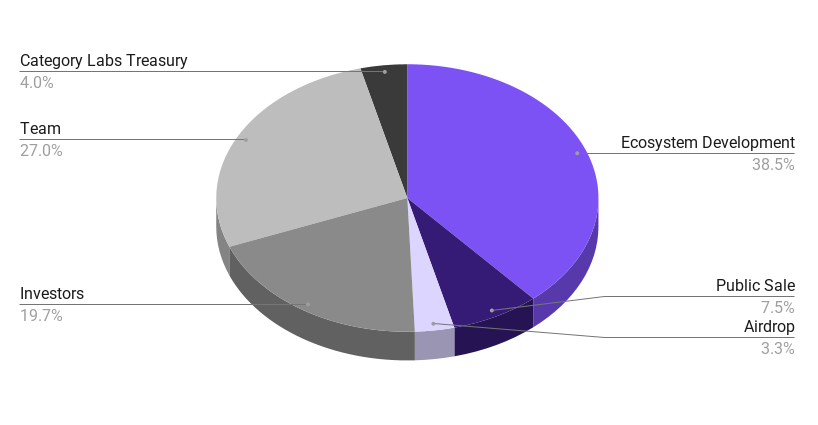Monad's long-awaited token plans landed with a split-screen reaction: a marquee debut on Coinbase's new token sale platform on one side, and a wave of anger from early supporters on the other. The Layer 1 project will sell 7.5% of its MON supply at an implied $2.5 billion fully diluted valuation (FDV), pointing to a roughly $187 million raise if fully filled, while allocating just 3.3% for an airdrop.
What's on the table
Alongside the sale reveal, Monad published its tokenomics. Between the airdrop and sale, only 10.8% of MON will initially be available to retail participants. More than half of the supply sits with investors, the team, and the treasury, setting the stage for a low-circulating-supply launch.

In pre-market trading on Hyperliquid, MON has been priced at an FDV near $6 billion—well above the sale's $2.5 billion mark—highlighting the kind of low-float dynamics that have powered sharp moves in recent launches.
The flashpoint: who gets what
The airdrop is small by community expectations and broad in scope: it doesn't just reward Monad-native contributors but includes general EVM users as well, whether or not they ever touched Monad. For supporters who've been active for years in the project's Discord, that landed poorly.
Auri, a long-time participant holding a rare "Mon" role in Monad's Discord, posted on X that, "I gotta say though this is not 'community first' tokenomics. For the first time with Monad, I feel the familiar sour taste of betrayal."
Investor concerns came from a different angle. "Monkey Rothschild," who says they invested on behalf of the Wassiverse NFT collection at a $600 million valuation, criticized the structure—specifically investor vesting versus what they say will be a 100% unlock for the public sale, as well as the slim airdrop. In one post on X, they wrote, "3 years, 3%. Not sure how else to spin it, but that's just dirty work lmfao," referring to the airdrop size relative to years of community activity. In a separate thread, they contrasted investor vesting schedules with the public sale's immediate unlock.
Not everyone is upset
Some market participants welcomed the specifics. "Coinbase sale + full tokenomics have made me more bullish monad tbh," investor Cryptopathic posted, adding that a tight float and the project's status as the first token offered via Coinbase's sale platform could be constructive for near-term price action.
Why this matters
- Ownership concentration and unlocks: With a majority of tokens earmarked for insiders and the treasury, secondary supply overhang will hinge on vesting, lockups, and any future emissions. That can support early price squeezes but create cliff risks later.
- Messaging vs. distribution: Projects promising broad community participation are facing renewed scrutiny when airdrops are modest or widely diffused beyond core contributors.
- Exchange-led sale platforms: Coinbase entering the sale arena formalizes a launchpad trend and could bring stricter compliance and wider retail access—albeit with jurisdictional limits and KYC.
- Pre-market signals: A $6B FDV in pre-market trading versus a $2.5B sale valuation sets the stage for volatile price discovery and highlights how low float can decouple initial trading from long-term fundamentals.
The bigger picture: lessons from recent L1 rollouts
Token distribution has become a defining feature of Layer 1 narratives. Over the last cycle, low-float launches often produced strong debuts only to face headwinds at major unlocks. Communities increasingly expect measurable allocations for contributors, ecosystem builders, and early testers—not just airdrops that spill over to broad EVM user sets.
Monad's design aligns with a growing playbook: lean initial float, a headline exchange partnership, and prominent market-making venues to bootstrap liquidity. That configuration can catalyze early momentum, but decentralization of ownership and governance can lag if insider and treasury stakes dominate.
Regulatory and access considerations
Having Coinbase run the sale signals an attempt to balance demand with compliance-minded distribution. Eligibility, geographic restrictions, and purchaser caps typically shape who can participate and how much they can buy. Those parameters, along with the reported public sale unlock versus investor vesting, will influence initial supply dynamics.
What to watch
- Final sale mechanics: Participation limits, pricing tiers, and settlement terms on Coinbase's platform will determine how distributed the initial float becomes.
- Vesting cadence: Exact cliffs and linear unlocks for investor, team, and treasury allocations will define future supply events—and potential overhang.
- Market convergence: Whether Hyperliquid's $6B pre-market pricing converges with the $2.5B sale valuation post-listing will be an early read on demand depth.
- Ecosystem incentives: Grants, liquidity programs, and builder subsidies can broaden ownership and offset concerns about concentration if implemented transparently.
Monad's token sale set-up delivers a high-profile launch with built-in scarcity. Whether that translates into a durable community base—or simply a brisk opening trade—will depend on how the team manages distribution, unlocks, and trust in the months ahead.
